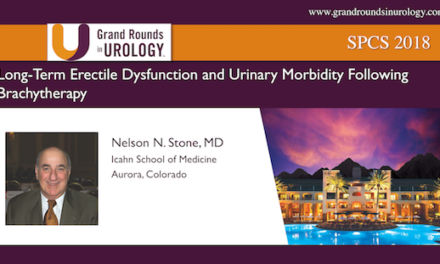How to cite: Khera, Mohit. “Changing Paradigms in Inflatable Penile Prosthesis Reservoir Placement.” October 2025. Accessed Dec 2025. https://grandroundsinurology.com/changing-paradigms-in-inflatable-penile-prosthesis-reservoir-placement/
Mohit Khera, MD, MBA, MPH, Professor and F. Brantley Scott Chair in Urology, Baylor College of Medicine, Houston, Texas, describes the historical background of the inflatable penile prosthesis, first developed at Baylor College of Medicine by F. Brantley Scott in 1973, and the long-standing search for the safest reservoir location. He explains that while early placement in the space of Retzius was common, this approach can lead to complications such as bladder perforation, iliac vein laceration, bowel injury, and herniation, especially in patients with prior pelvic surgery or radiation.
Dr. Khera highlights the evolution toward ectopic and submuscular techniques. In 2002, Dr. Steve Wilson introduced submuscular placement below the rectus muscle, above the transversalis fascia. Early use of round reservoirs risked herniation and visibility. The introduction of flat reservoirs in 2010 improved concealment and reduced complications.
Dr. Al Morey described high submuscular placement. Additional fixation strategies were introduced, including the THALIA Stitch from Mayo Clinic, which anchors reservoir tubing to the pubic bone, and the transfascial fixation (TFF) technique developed at Baylor. Dr. Khera explains that TFF involves exteriorizing and suturing the tubing through the fascia to eliminate the risk of herniation.
Dr. Khera reports Baylor’s published series of 31 cases using low submuscular placement with TFF. Patients experienced no revisions or complications, and reported only minor palpable findings that did not affect comfort. He emphasizes that this approach is now the preferred strategy, particularly in patients with prior radical prostatectomy, where abdominal entry is less desirable. He argues that low submuscular placement with TFF provides a reliable balance of safety, durability, and patient satisfaction.
ABOUT THE AUTHOR
Mohit Khera, MD, MBA, MPH, is a board-certified urologist specializing in male infertility, male and female sexual dysfunction, and declining testosterone levels in aging men. Dr. Khera’s research focuses on the efficacy of botulinum toxin type A in treating Peyronie’s disease as well as genetic and epigenetic studies on post-finasteride syndrome patients and testosterone-replacement therapy.
Dr. Khera earned his MBA and MPH from Boston University before earning his MD from the University of Texas Medical School at San Antonio. Dr. Khera completed his urology residency training in the Scott Department of Urology at Baylor College of Medicine (BCM) where he also completed a one-year general surgery internship. After completing his urology residency, he went on to complete a one-year fellowship in Male Reproductive Medicine and Surgery at BCM. Currently Dr. Khera is a professor in the Scott Department of Urology at Baylor College of Medicine, and he holds the F. Brantley Scott Chair in urology. Dr. Khera also serves as the director of the Laboratory for Andrology Research, the medical director of the Baylor Executive Health Program and the medical director of the Scott Department of Urology. He also serves as president of the Sexual Medicine Society of North America.
Dr. Khera has initiated numerous FDA-approved clinical trials. His scientific and clinical experiences have allowed him to thus far give over 400 lectures at scientific meetings throughout the world, publish over 160 articles in peer-reviewed journals, complete 15 book chapters, and edit and write two books in the field of sexual medicine and men’s health. Dr. Khera shares his time and knowledge with the general public. He has been voted several times as one of Houston’s Best Doctors by Health and Sport Fitness Magazine and by Houstonia Magazine and is a frequent guest on such TV programs as Fox News’ “Ask theDoctor.” He also writes a blog on men’s health for the Houston Chronicle newspaper.





